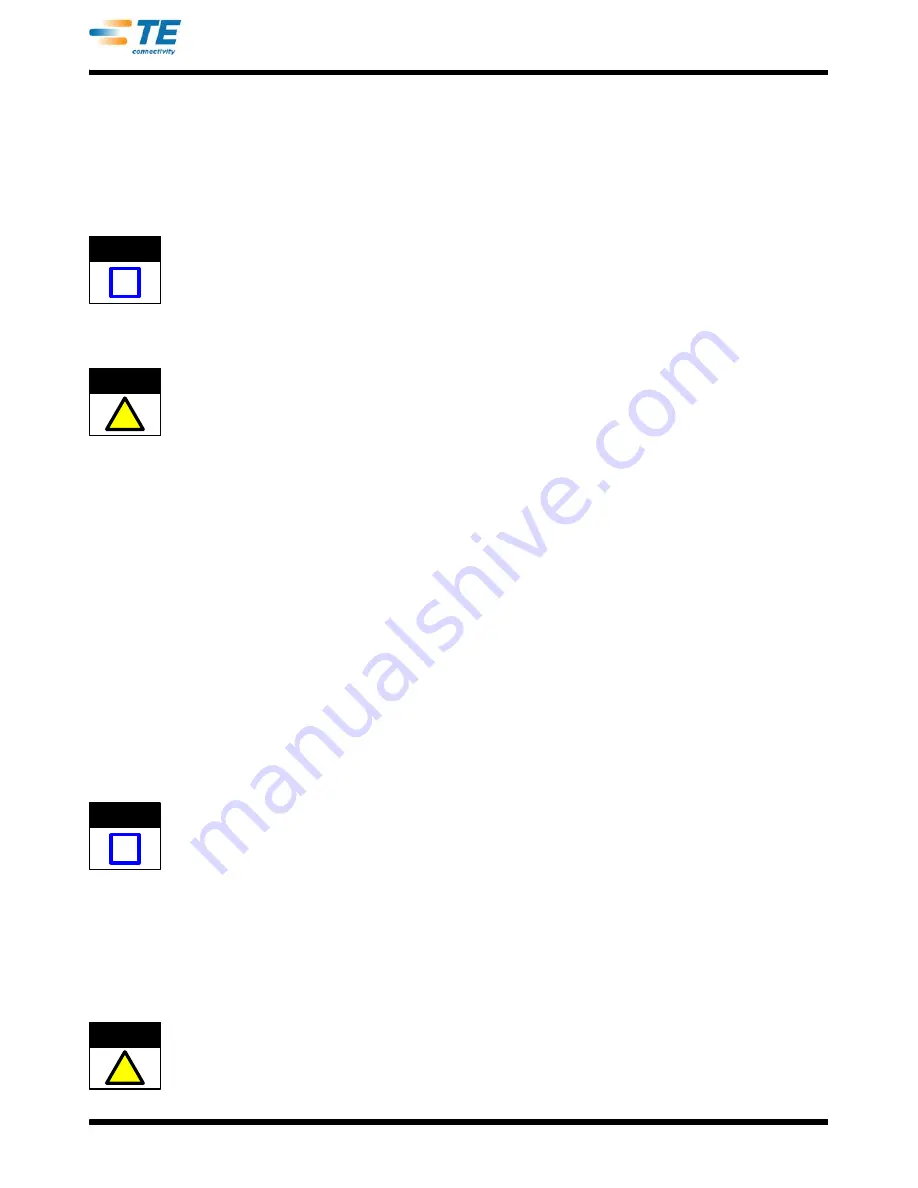
408- 1559
Rev
T
6
of 10
4. INSULATION CRIMP ADJUSTMENT
The insulation crimp section of the hand tool has
three positions: 1 (tight), 2 (medium), and 3 (loose) to
adjust the wire insulation crimp grip. To adjust the
insulation grip, proceed as follows:
4.1. PIDG Terminals and Splices and
PIDG FASTON Receptacles
PIDG terminals and splices feature a wire
insulation “grip.”
1. Insert the insulation crimp adjustment pins into
Position 3. Refer to Figure 1.
Make sure that both insulation crimp adjustment
pins are in the same position.
2. Place a terminal or splice into the tool jaws as
shown in Figure 4 or Figure 5.
3. Insert UNSTRIPPED wire into ONLY the
insulation barrel of the terminal or splice.
4. Close the tool handles to complete the crimp.
5. Remove the crimped terminal or splice and
check the insulation crimp by bending the wire
back and forth once. The terminal or splice should
retain its grip on the wire insulation. If the wire pulls
out, set BOTH insulation crimp adjustment pins to
the next higher position (2).
6. Perform another crimp, and repeat the
adjustment as necessary until the correct insulation
grip is attained. DO NOT use a tighter setting than
required.
4.2. PLASTI- GRIP Terminals and Splices
PLASTI--GRIP terminals and splices feature a
wire insulation “support.” The terminal or splice
insulation should ideally be in contact with the
wire insulation.
Set the insulation crimp adjustment pins into position
according to the following:
— 3 for wire having large insulation diameter
— 2 for wire having a medium insulation diameter
— 1 for wire having a small insulation diameter
Make sure that both insulation crimp adjustment
pins are in the same position.
5. MAINTENANCE AND INSPECTION
Hand crimping tools are inspected before shipment.
The tool received should be inspected immediately
upon arrival to ensure that the tool has not been
damaged during shipment, and that it performs
according to the criteria described in this sheet. If a
tool is damaged upon arrival, retain the shipping
container, file a claim with the carrier, and notify TE
immediately.
5.1. Daily Maintenance
1. Remove dust, moisture, and other contaminants
from the tool with a clean brush or a soft, lint--free
cloth. DO NOT use objects that could damage the
tool.
2. Make sure that the proper retaining pins are in
place and are secured with the proper retaining
rings.
3. Make certain that all pins, pivot points, and
bearing surfaces are protected with a THIN coat of
any good SAE 20 motor oil. DO NOT oil
excessively.
4. When the tool is not in use, keep the handles
closed to prevent objects from becoming lodged in
the crimping areas and store the tool in a clean,
dry area.
5.2. Periodic Inspection
Regular inspections should be performed by quality
control personnel. A record of scheduled inspections
should remain with the tool or be supplied to
supervisory personnel responsible for the tool.
Though recommendations call for at least one
inspection per month, the inspection frequency should
be based on the amount of use, working conditions,
operator training and skill, and established company
standards. These inspections should be performed in
the following sequence:
A. Visual Inspection
1. Remove all lubrication and accumulated film by
immersing the tool (handles partially closed) in a
suitable commercial degreaser that will not affect
paint or plastic material.
2. Make certain that all retaining pins are in place
and are secured with retaining rings. If
replacements are necessary, refer to the parts list
in Figure 10.
3. Inspect crimping areas for pitted or chipped
surfaces.
4. Close the tool handles until the ratchet releases,
then allow handles to open freely. If they do not
open quickly and fully, the spring is defective and
must be replaced. Refer to Section 6,
REPLACEMENT AND REPAIR.
NOTE
i
CAUTION
!
NOTE
i
CAUTION
!




























